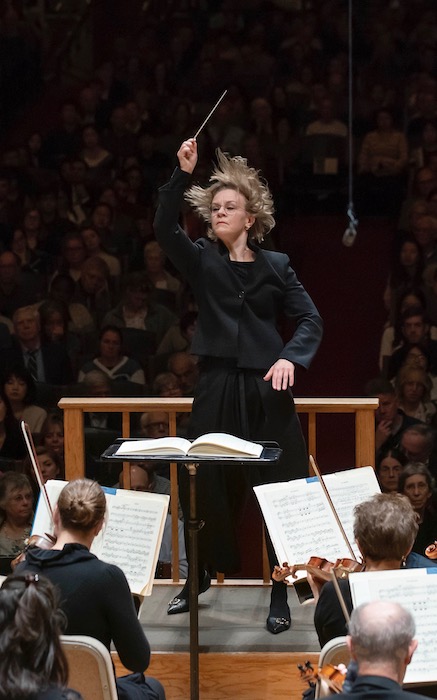Haefliger, BSO give an intense and eclectic piano concerto a brilliant U.S. premiere

After an absence of nearly nine years, Susanna Mälkki returned to the Boston Symphony Orchestra’s podium Thursday night at Symphony Hall. An inventive programmer and discerning musician, the Finnish conductor led a typically eclectic mix of pieces by Fauré, Messiaen, and Debussy, as well as the American premiere of the Swiss composer Dieter Ammann’s The Piano Concerto (“Gran Toccata”).
Co-commissioned by the BSO, the Ammann is a hyper-virtuosic, thirty-minute-long essay that holds very little back, instrumentally or technically. The writing for soloist and big ensemble (triple woodwinds, expanded percussion, etc.) is tightly integrated. Sometimes the piano functions as a unit with other instruments in the larger group (particularly marimba and vibraphone). At other points, keyboard and orchestra engage in a spastic free-for-all, in which the former is often subsumed into the fabric of the latter.
Fewer are The Piano Concerto’s introspective, lyrical, and/or unaccompanied solo moments. But those provide welcome respite by their contrast.
Indeed, Ammann’s writing in the piece is intense, demanding, and multi-layered. Motoric textures abound. Echoes of jazz, funk, and rock crop up. So do subtle hints of Gershwin and Rachmaninoff. Over the work’s last half, beguiling microtonal episodes unfold.
Admittedly, that’s a lot to take in. Even so, on first hearing, The Piano Concerto doesn’t quite add up to the sum of its parts.
Not that it lacks for stirring spots. The generative opening part, in which the orchestra echoes and transforms the piano’s repeated A’s, is inventive and striking. Equally enchanting is the stratospheric keyboard and violin writing with brass and percussion swells unfolding underneath around its midpoint. The microtonal portions are sumptuous. And the rich brass chorale punctuated by chiming bells and piano just before the end is downright haunting.
If only more of the piece were inspired like that latter idyll. On Thursday, too much of The Piano Concerto came over as an unrelenting barrage of ideas, often frenetically scored and densely packed. Coloristic effects, rhythmic verve, thundering textures, and sheer virtuosic display carry it so far, but, as the music unfolds, it suffers from a certain redundancy of gesture and a need for greater textural variety.
That’s especially true of its pummeling, driving segments: they constitute about two-thirds of the score, and, after ten minutes or so, have simply overstayed their welcome. Ultimately, then, it’s an open question whether or not The Piano Concerto justifies its structure and duration.
Regardless, Thursday’s U.S. premiere was brilliantly played. Ammann wrote The Piano Concerto for Andreas Haefliger and he performed it with demoniac energy, and stunning endurance, offering plenty of power when called for. But it was his fleet fingerwork in the score’s lightly scored passages that stood out most: silver-toned, clean, and breathtakingly dexterous.

Mälkki, an exceptional advocate for complex new scores, had a tight handle on the orchestral proceedings. A couple diffuse textures notwithstanding, she drew playing of terrific energy, taut balances, and bright color from the BSO. The brass and percussion sections, in particular, glowed.
They were radiant, too, in Debussy’s La Mer, which closed the evening. True, these “three symphonic sketches” are part of the BSO’s DNA: the orchestra gave La Mer’s American premiere in 1907 and have subsequently played it more than three hundred times. But Mälkki teased out a fresh sense of atmosphere and drama in these familiar pages on Thursday.
The opening “From Dawn to Noon on the Sea” was marked by firm rhythms, grand perorations, and, above all, diaphanous sonorities: its subtle details (the delicate harp writing, pulsing inner string tattoos, etc.) all spoke briskly.
“Play of the Waves” was shaped with the utmost attention to dynamic extremes and whimsical character. A similar approach to the former marked the seething “Dialogue of the Wind and the Sea”: its huge climaxes packed a visceral punch.
Before the Debussy came the BSO’s first performance in nearly sixty years of Olivier Messiaen’s “Alleluia on the Trumpet, Alleluia on the Cymbal.” Taken from his 1933 symphonic suite L’Ascension, “Alleluia” is an instrumental meditation on the celebratory forty-seventh Psalm, full of stirring fanfares and snappy, dancing rhythms.
Thursday’s reading of this short piece was bracing, highlighted by robust trumpet sennets, burnished horn melodies, beautifully balanced unison woodwind lines, and crisply gamboling string figures.
To begin the night, Mälkki led the BSO in a plush, shapely account of Gabriel Fauré’s Pavane. All of the concert’s best qualities – the thoughtful attention to pacing, dynamics, color, and phrasing – were on full display in this dulcet opener, nowhere more impressively so than in principal flute Elizabeth Rowe’s melting solos.
The program will be repeated 1:30 p.m. Friday and 8 p.m. Saturday at Symphony Hall. bso.org; 888-266-1200
Posted in Performances